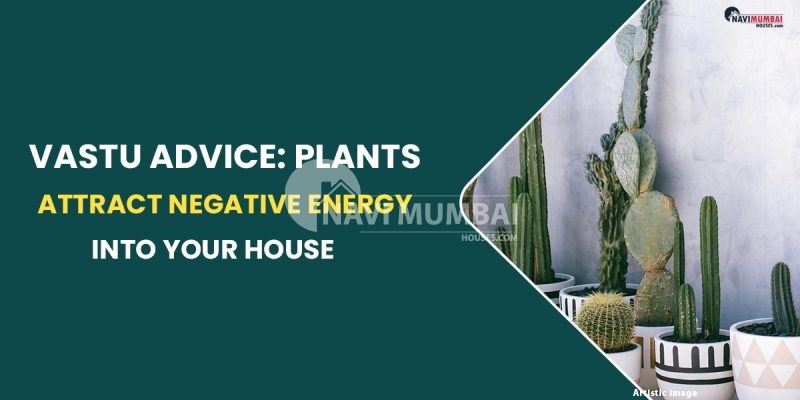Vastu Negative Energy Plants- According to Vastu, dead plants are terrible because they release negative energy. Certain plants are said to convey bad energy and upset the harmonic balance of energies within a home, according to Vastu Shastra, the ancient Indian science of construction. Keep these plants away from your living area to achieve harmony. We’ll look at five plants in this article that are bad for your home according to Vastu and ought to be avoided.
Are you searching flat for rent in kharghar?
Negative vastu plant #1: Bonsai
Vastu discourages the use of bonsai plants because they represent stunted or sluggish growth, which can disrupt an inhabitant’s life cycle. Bonsai plants grow best in open areas such as gardens or verandahs; they should not be placed anyplace else in the house.
Bonsai plants are prize for their visual attractiveness due to their tiny and meticulously manicured forms. But according to Vastu Shastra, the energy of the room these well-design plants occupy is thought to be negatively impact by them.
Creating a harmonious & balanced atmosphere that promotes the success and well-being of the residents is the fundamental goal of Vastu Shastra. It is believed that the sluggish growth of bonsai plants inhibits the flow of positive energy and the personal growth of the people occupying that space.
This interference can affect many facets of life, such as the development of a job and business. Because bonsai plants represent sluggish or limited development, they could unintentionally affect the opportunities and speed of your career path.
Although bonsai trees make interesting accents to patios or gardens, you should avoid bringing them indoors. You can foster an environment that is open and supportive of both professional and personal growth in your home by removing bonsai plants from the inside.
Why is open space preferable?
Plants can grow freely and flourish in natural settings, such gardens or verandahs. On the other hand, the Vastu Shastra’s ideas of free-flowing energy are incompatible with the constrained and controlled growth of bonsai plants.
In open areas, letting plants grow naturally promotes the flow of good energy throughout your environment. This open space encourages a sense of vitality & richness by supporting the growth and health of both people and plants.
Therefore, if you have a fondness for bonsai plants, think about putting them in areas that are open to the elements so they can grow freely. This method enhances your general well-being while honouring the principles of Vastu Shastra and letting you appreciate the beauty of bonsai plants.
Pros of placing Bonsai plants in open spaces
Cons of placing Bonsai plants indoors
Promotes free-flowing energy
May interfere with the occupants’ life cycle
Creates a vibrant and abundant atmosphere
Can impede career and business growth
Allows the plants to grow naturally
Symbolises slow or restricted growth
Negative vastu plant #2: Cactus
According to Vastu, cactus is bad because of their sharp thorns, which are thought to carry negative energy and cause worry, anxiety, and bad luck for the family. These plants are thought to bring worry and anxiety into the home and are frequently connect to bad luck.
Interestingly though, cactus can actually serve as defenders by warding off bad energy when they are positioned correctly, like by the window or on the patio. Positive vibrations can be absorb and neutralize by them, resulting in a more harmonic and balanced living environment.
Cactus placement tips
To enhance their protective qualities, it’s crucial to think about where to put cactus in your house:
To prevent negative energy from entering your home, place cacti close to the entryway.
Cacti should be placed in a room’s corners to absorb any negative energy.
To encourage a sense of peace and quiet, think about adding cactus to spaces that are prone to stress or worry, including the home office or bedroom.
You may take use of cacti’s defensive properties and create a room that is protect from negative energy by carefully putting them throughout your house. This will foster a more upbeat and peaceful mood.
Positive aspects
Negative aspects
Help create a harmonious living space
Thorns are associate with stress and misfortunes
Act as protectors against negative energy
Believed to bring bad luck and anxiety
Absorb and neutralize negative vibrations
Negative vastu plant #3: Mehendi
According to Vastu, mehendi, or myrtle plants, which are frequently used to create lovely designs on hands during auspicious occasions like weddings, are unfortunate. Vastu Shastra holds that these plants are home to evil spirits & can infuse the house with unfavourable thoughts and energies. In order to keep your living space peaceful and happy, it is advised against putting mehendi plants there.
Other plants to avoid
Tamarind tree: It is said that bad energy is drawn to tamarind trees. As such, it is advised against planting it close to your house in accordance with Vastu principles.
Aspect
Mehendi
Tamarind tree
Auspiciousness
Unlucky
Avoid planting near home
Beliefs
Mehendi plants are considered to be unlucky and are said to harbour malevolent spirits that bring bad vibes.
Vastu principles suggest that the attraction of bad energy is associated with tamarind trees.
Negative vastu plant #4: Cotton plant
Despite being snow-white and attractive as a decorative feature, cotton plants are unfortunate and unfavourable for a home according to Vastu. According to Vastu principles, they should be avoided since they are said to bring ill luck.
Gossypium, the cotton plant, is a tiny shrub that is a member of the Malvaceae family. It is well-known for its fluffy, silky fibres that are used all over the world to create textiles and clothing. However, the cotton plant is considered an unlucky plant in Vastu Shastra and should not be maintained indoors.
Symbolism and beliefs
The cotton plant is connected to poor luck and is thought to bring negative energy into the home, according to Vastu principles. Given that cotton is frequently used in funerals & cremations, the plant’s bad reputation stems from its associations with death and grieving customs.
Moreover, the cotton plant’s association with the conclusion of a plant’s life cycle makes it unlucky. According to Vastu, plants that represent death or the end of growth interfere with the flow of positive energy and cause imbalances in the house.
Decorative element vs. vastu
As a decorative feature, cotton plants can be aesthetically pleasant, but according to Vastu principles, the energy & harmony of the living space should take precedence. Thus, it’s best to stay away from maintaining cotton plants indoors in order to avoid drawing unfavourable luck and energy.
Alternative Decorative Plants
Consider alternatives like the Money plant, Jade plant, and Peace Lily if you’re searching for ornamental plants that are good in Vastu. It is said that these plants draw good energy and make your house seem peaceful.
Pros
Cons
Can be used as a decorative element
Symbolises death and the end of growth
Snowy white and visually appealing
Associated with bad luck
Soft and fluffy fibres
Believed to disrupt positive energy flow
Negative vastu plant #5: Dead plants
According to Vastu, dead plants are terrible because they release negative energy. Vastu Shastra states that having fresh, green, and flowering indoor plants is essential to maintaining a positive energy flow in your house.
Plants that die or start to wither might leave behind a stagnant energy that can negatively impact the energy in your living area as a whole. Dead or dying plants should be taken out of the area right away in order to preserve harmony in the surrounding area.
You can increase the positive energy in your house by getting rid of any dead plants and adding new, colourful ones in their place. An atmosphere of uplift and rejuvenation is create in your living space when blooming flowers are present because they offer beauty and vitality.
Poisonous and toxic plants you shouldn’t keep at home
Certain plants can infiltrate your home with negative energy, but other plants directly endanger your health. It is best to stay away from these dangerous and toxic plants, especially if you have kids or pets. Here are some instances of plants to avoid:
Sago Palm
Despite its seemingly innocuous appearance, the sago palm is a poisonous plant whose seeds contain cycasin. Symptoms from consuming these seeds include diarrhoea, vomiting, liver failure, & even death. Sago palms should not be kept indoors, and if you do have some in your garden, proceed with caution.
Lilies
In addition to being exquisite, lilies are poisonous to both people and animals. They may induce nausea and vomiting if consumed. They may potentially be lethal in certain situations. It’s crucial to keep lilies out of reach & away from your house, particularly if you live with cats.
Dumb Cane
Because of its luxuriant leaves, the dumb cane, also called Dieffenbachia, is a popular houseplant. But if eaten or swallowed, the crystals of calcium oxalate it contains can irritate the tongue and throat severely. Remove this plant from children’s and dogs’ reach to avoid any unintentional consumption.
English Ivy
A popular climbing vine for its visual appeal is English ivy. On the other hand, toxins found in its leaves have the potential to irritate skin or induce dermatitis when touched. English ivy should not be kept indoors; handle it carefully, especially if you have sensitive skin.
You may safeguard your loved ones’ safety and make your house healthier by being aware of these poisonous plants & avoiding their presence.
Plant
Toxicity
Symptoms
Dumb Cane
Moderately toxic
Mouth and throat irritation
Lilies
Highly toxic
Stomach upset, vomiting, potential fatality
English Ivy
Moderately toxic
Dermatitis, skin irritation
Sago Palm
Highly toxic
Vomiting, diarrhoea, liver failure, potential fatality
Other things to think about and unlucky trees to avoid
In addition to the particular unfavourable Vastu plants, there are other things to think about. It’s best to keep the area tidy and clutter-free by getting rid of extra plants and keeping everything orderly. This generates a peaceful living environment and encourages the flow of positive energy.
Furthermore, nightshade plants—which include potatoes, tomatoes, and brinjal—are said to have bad energy and need to be avoided in Vastu. These plants can upset the home’s energy balance and are frequently linked to toxicity.
In addition, certain trees should not be placed close to the property since they are unlucky according to Vastu. It’s said that the tamarind, date palm, bamboo, and babul trees draw bad energy and lead to arguments between family members.
You’re looking for Projects in Sanpada have the Best Properties In Navi Mumbai Like Ready to Move:https://navimumbaihouses.com/properties/search/sanpada/
If you want daily property update details please follow us on Facebook Page / YouTube Channel / Twitter
The post Vastu Advice: Plants That Attract Negative Energy Into Your House appeared first on .

